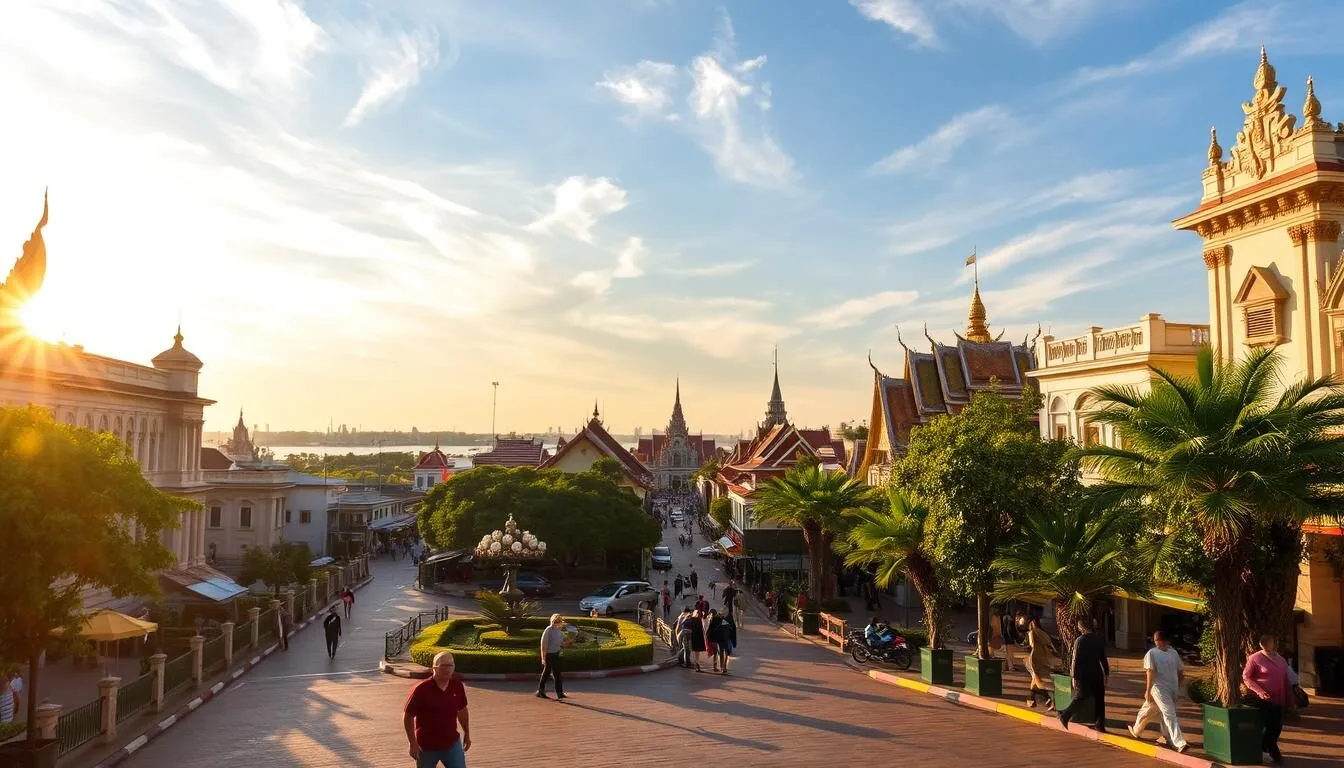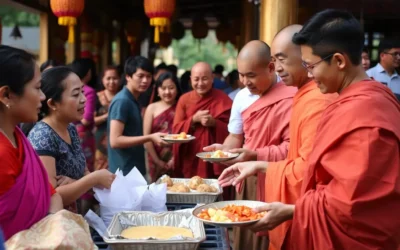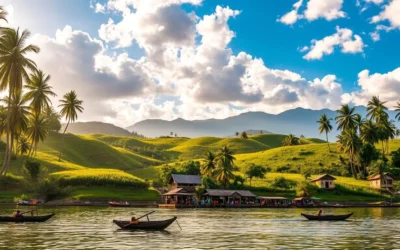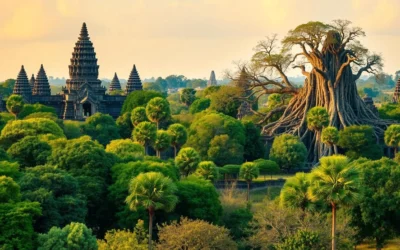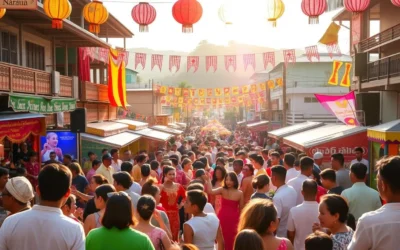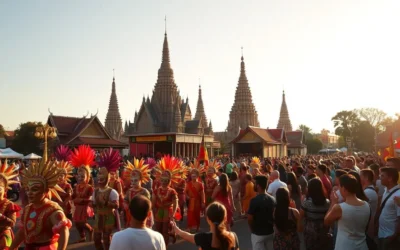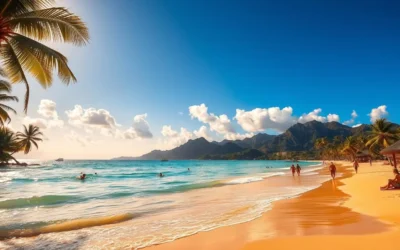✓ Accommodations✓ Flights✓ Rental Cars✓ Tours & Activities
Did you know that Cambodia’s weather can significantly impact your travel experience? With only two distinct seasons, the wet and dry periods, timing your visit is crucial.
Understanding the local weather patterns can make all the difference between enjoying clear skies at iconic sites or navigating through monsoon rains.
This guide will help you identify the ideal time to visit Cambodia’s capital city and surrounding attractions, ensuring you’re prepared for the weather conditions.
By knowing what to expect, you can plan your trip accordingly and make the most of your time in this Southeast Asian gem.
Cambodia’s Climate: What to Expect Year-Round
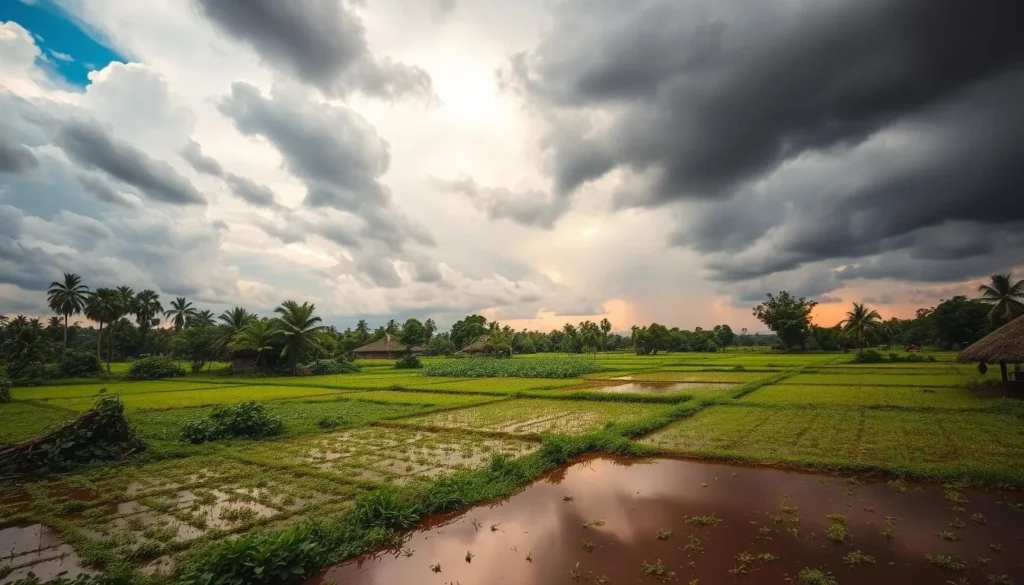
Cambodia’s climate is characterized by a simple two-season system that significantly impacts your travel experience. Understanding the characteristics of each season is crucial for planning your trip.
The Two-Season System: Wet vs. Dry
Cambodia operates on a straightforward two-season climate system: the wet season and the dry season. The wet season, which runs from mid-April to October, is influenced by the Southwest monsoon, bringing afternoon downpours that typically last about 30 minutes before clearing to blue skies. During this time, temperatures often reach the high 80s (27°C) with increased humidity, making it feel hotter than the actual temperature.
Monthly Temperature and Rainfall Patterns
The dry season, from November to mid-April, sees very little rainfall due to the dusty Northeast monsoon, which dries out the country quickly. This period features consistently sunny days with lower humidity and slightly cooler temperatures, typically in the 70s°F (low to mid-20s°C). Rainfall patterns vary significantly between seasons, with September experiencing the heaviest precipitation and January-February being the driest months.
Key characteristics of Cambodia’s climate include:
– The wet season brings the Southwest monsoon with afternoon downpours.
– Temperatures during the wet season often reach the high 80s (27°C) with increased humidity.
– The dry season features sunny days with lower humidity and cooler temperatures.
– Rainfall patterns vary, with September being the wettest and January-February the driest.
By understanding these climate variations, you can better prepare for your trip to Cambodia, ensuring a more enjoyable and weather-savvy travel experience throughout the year.
Phnom Penh, Cambodia: Best Months for a Weather-Savvy Trip
For a weather-savvy trip to Phnom Penh, Cambodia, knowing the ideal travel months is crucial. The city’s climate is characterized by two main seasons: wet and dry. Understanding these seasons will help you plan your trip accordingly.
November to February: The Prime Window
The prime window for visiting Phnom Penh falls between November and February. During these months, you can expect pleasant temperatures, minimal rainfall, and lower humidity levels. Daytime temperatures typically range from 75-85°F (24-29°C), creating ideal conditions for exploring the city’s outdoor attractions and nearby sites.
November marks the beginning of the dry season, offering a perfect balance of good weather and fewer tourists compared to the peak period in December and January. February provides excellent conditions with warm days and cooler evenings, though tourist numbers begin to increase as the month progresses.
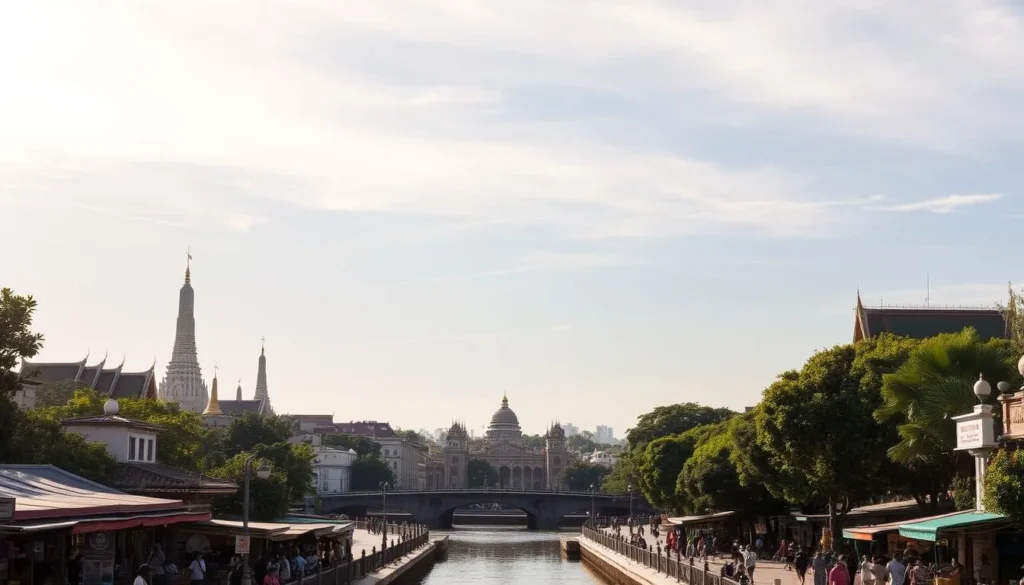
Shoulder Seasons: March-April and October
If you’re looking for alternatives to the peak season, consider the shoulder seasons of March-April and October. These periods offer distinct advantages and challenges for weather-conscious travelers. March and April see gradually increasing temperatures that can reach the 90s°F (mid-30s°C), but still maintain relatively dry conditions before the monsoon arrives.
October represents the transition from wet to dry season, with decreasing rainfall and the landscape at its lushest after months of rain. Traveling during these shoulder seasons often means better accommodation rates and less crowded attractions while still enjoying reasonably good weather.
Navigating the Dry Season: November to April
The dry season, spanning from November to mid-April, is the best time to visit Phnom Penh, with minimal rainfall and pleasant weather conditions. This period offers a fantastic opportunity to explore the city’s attractions without the disruptions caused by wet weather.
Peak Tourist Months: December and January
December and January are the peak tourist months when visitor numbers reach their highest levels at popular sites throughout Cambodia. You’ll experience near-perfect weather conditions with temperatures averaging 75-80°F (24-27°C), clear blue skies, and minimal chance of rain. This makes it an ideal time for outdoor activities and exploring the city’s temples and attractions.
Benefits of Clear Skies and Lower Humidity
The consistently dry weather during this period makes it perfect for outdoor activities, temple exploration, and day trips to nearby attractions without weather concerns. Lower humidity levels during the dry season, particularly from December to February, create more comfortable conditions for walking tours and extended outdoor excursions.
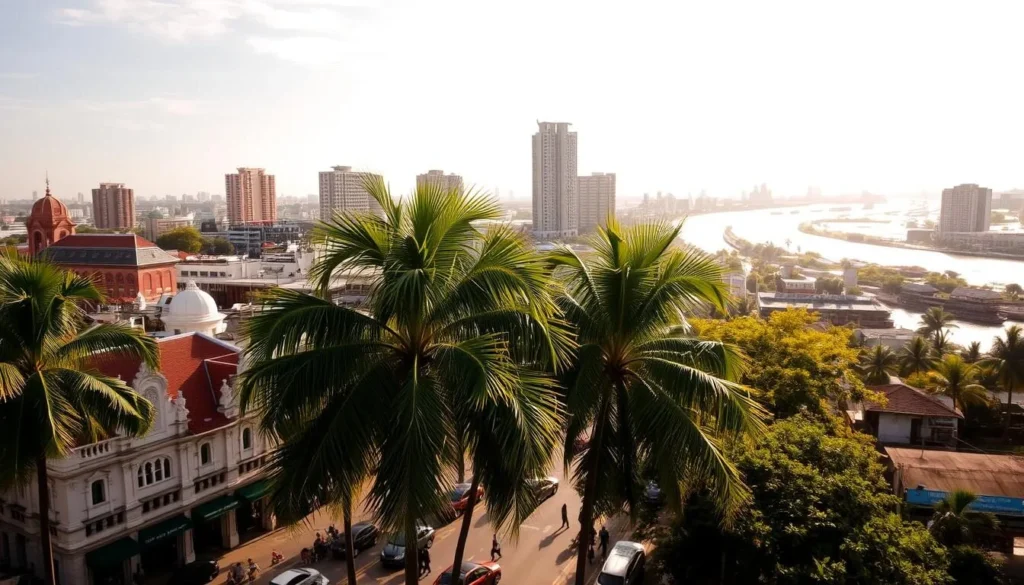
Managing Higher Prices and Larger Crowds
The trade-off for perfect weather comes in the form of higher accommodation prices, which can increase by 30-50% compared to wet season rates. Popular attractions become significantly more crowded during peak months, with major sites like the Royal Palace and National Museum experiencing their busiest periods. To mitigate crowd issues, consider visiting these sites during early morning or late afternoon when they are less busy.
Exploring During the Wet Season: May to October
Phnom Penh’s wet season is not just about rain; it’s a time of lush landscapes and fewer tourists. While the wet season, which spans from May to October, might deter some travelers, it brings its own unique charm to the city.
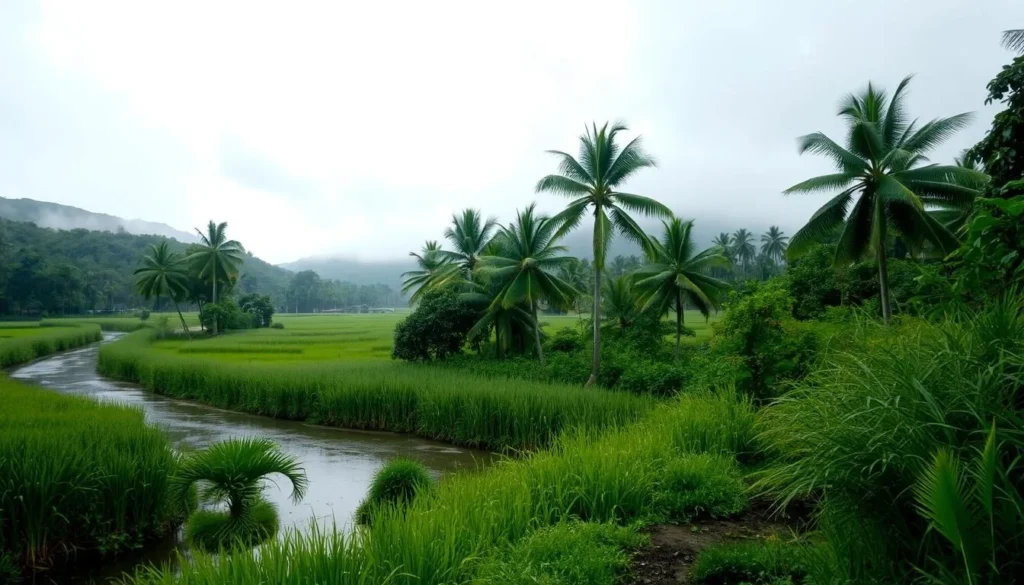
Understanding Monsoon Patterns
The wet season in Phnom Penh is characterized by regular afternoon rainfall. However, contrary to common perception, it doesn’t rain all day, every day. Typical monsoon patterns involve sunny mornings followed by intense but brief afternoon downpours lasting 30-60 minutes before clearing again. September experiences the heaviest rainfall, making it the most challenging month for weather-dependent activities and outdoor exploration.
The “Green Season” Advantage: Lush Landscapes
The wet season is also known as the “green season” due to the landscape being hydrated by the rain and flourishing in shades of lush green. The “green season” transforms Cambodia’s landscapes into vibrant, lush scenery with rice paddies at their most photogenic and vegetation at its most abundant. This creates unique photography opportunities with dramatic skies, reflective surfaces, and the rich contrast of ancient temples against verdant greenery.
Budget-Friendly Travel and Fewer Tourists
Traveling during the wet season offers significant cost savings. Hotel rates are often discounted by 30-40%, and there are better deals on tours and activities. Tourist numbers drop considerably during these months, allowing for more peaceful exploration of popular attractions without the crowds of peak season. You can plan most sightseeing earlier in the day and use afternoon rain showers as a time to rest or enjoy indoor activities.
- The wet season brings regular afternoon rainfall, but it doesn’t rain all day.
- September is the wettest month, making it challenging for outdoor activities.
- The “green season” offers lush landscapes and unique photography opportunities.
- Traveling during the wet season is budget-friendly with discounted hotel rates and fewer tourists.
Seasonal Highlights in Phnom Penh and Beyond
As the seasons change, Phnom Penh and its surroundings transform, offering unique experiences for visitors. The city’s cultural festivals, day trips, and attractions are all influenced by the wet and dry seasons, making the time of year an important consideration for travelers.
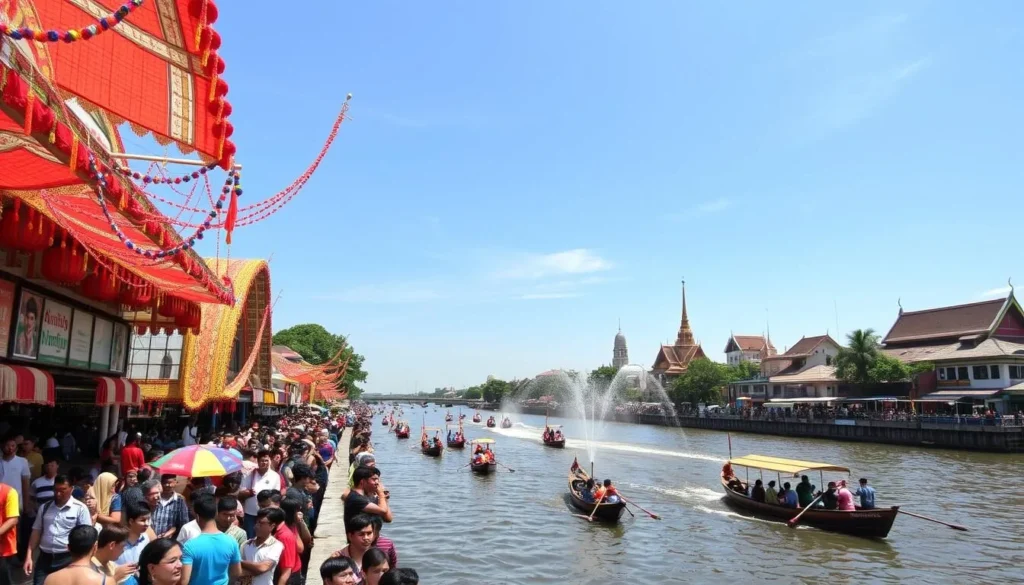
Cultural Festivals and Weather Considerations
Phnom Penh hosts several significant cultural festivals throughout the year, enhancing your travel experience if timed correctly. The Water Festival (Bon Om Touk) in November marks the reversal of the Tonle Sap River’s flow with colorful boat races, fireworks, and celebrations along the riverfront. Additionally, Khmer New Year in mid-April brings vibrant celebrations, traditional games, and temple visits throughout the capital.
The Royal Palace and Silver Pagoda are key attractions year-round but are particularly stunning against clear blue skies during the dry season months.
Day Trips from Phnom Penh: Seasonal Accessibility
Day trips from Phnom Penh to nearby attractions like Tonle Sap Lake are significantly affected by seasonal water levels. The lake expands dramatically during the wet season, making it an ideal time to visit the floating villages. Visiting Tonle Sap is most impressive from July to December when water levels are at their highest.
Excursions to the Angkor temples near Siem Reap are more comfortable during the dry season but offer unique photographic opportunities with fewer crowds during the wet months.
Practical Tips for Weather-Ready Travel
Whether you’re visiting during the dry or wet season, there are several practical tips to ensure a smooth trip to Phnom Penh. Being prepared for the local weather conditions can make a significant difference in your travel experience.
Packing Essentials for Each Season
Packing appropriately for Cambodia’s distinct seasons is crucial for comfort throughout your trip. For the dry season, lightweight, breathable clothing is essential, along with sun protection including wide-brimmed hats, high-SPF sunscreen, and sunglasses. In contrast, wet season travelers should pack quick-dry clothing, a lightweight rain jacket or poncho, and waterproof footwear.
Transportation Considerations During Wet vs. Dry Months
Getting around Phnom Penh is relatively easy when you know your options. During the dry season, tuk-tuks and taxis are reliable choices. However, during the wet season, it’s advisable to plan for potential delays due to weather conditions. Ferries and buses may take longer, so it’s essential to allow extra time for your journeys.
| Season | Transportation | Precautions |
|---|---|---|
| Dry Season | Tuk-tuks, Taxis | Sun protection |
| Wet Season | Buses, Ferries | Plan for delays |
Accommodation Choices Based on Weather Patterns
When choosing your accommodation, consider the location relative to major attractions to minimize travel during potential rain showers in the wet season. Properties with covered walkways, indoor restaurants, and pool facilities provide welcome respite during both the intense heat of the dry season and the afternoon showers of the wet season.

By being mindful of these practical tips, you can ensure a more enjoyable and stress-free trip to Phnom Penh, regardless of the weather.
Conclusion
Whether you’re drawn to the dry season or the lush landscapes of the wet season, Phnom Penh has something to offer. The best time to visit largely depends on your preferences regarding weather, budget, and crowd tolerance.
For most travelers, the period from November to February provides the optimal balance of pleasant temperatures and minimal rainfall, making it ideal for exploring Angkor Wat and other cultural gems. The shoulder months offer a good alternative with fewer crowds.
Understanding Cambodia’s seasonal patterns allows you to plan activities and pack accordingly, ensuring a rewarding travel experience. With proper preparation, both the wet and dry seasons can offer unique insights into Cambodian culture, including events like the Water Festival and Khmer New Year celebrations.
The above is subject to change.
Check back often to TRAVEL.COM for the latest travel tips and deals.
